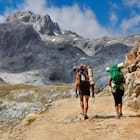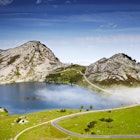
This stunning mountain wonderland is Spain's newest national park

Jun 29, 2021 • 3 min read

Yunquera in Malaga is within the new park © Getty Images / Cavan Images RF
Extending northwest from sunny ²Ñá±ô²¹²µ²¹ and southeast from the white town of Ronda, near Marbella in far-southern Spain, ´¡²Ô»å²¹±ô³Ü³¦Ã²¹â€™s serene Sierra de las Nieves has been on the cusp of becoming a national park for over six years. Now, after much anticipation (not to mention a few COVID-19 delays), and thanks to dedicated, hands-on campaigning by local communities, it has finally received official approval. The Parque Nacional Sierra de las Nieves is Spain’s 16th national park, the third to arrive in ´¡²Ô»å²¹±ô³Ü³¦Ã²¹ and the very first for ²Ñá±ô²¹²µ²¹ province, and there are high hopes that its establishment will help revive this rural region.
Often dusted with snow in deep winter, this sparsely-populated mountain wonderland has been a protected 201-sq-km parque natural (natural park) since 1989, and half of it a Unesco Biosphere Reserve for 25 years. The newly declared national park is home to around 1000 ibex, as well as roe deer, otters, various raptors (including golden eagles) and rippling oak and cork groves, but is particularly special for its forests of rare, ancient pinsapos (Spanish firs) – relics from the Iberian Peninsula’s Ice Age found only in three pockets of southern Spain and in northern Morocco. Around 65% of Spain’s pinsapos stand within the Sierra de las Nieves; the most famous is the Pinsapo de las Escaleretas, thought to be between 350 and 550 years old.
´¡²Ô»å²¹±ô³Ü³¦Ã²¹â€™s much-awaited third national park now takes in 230 sq km of rugged ²Ñá±ô²¹²µ²¹ mountains, with funding being put towards new visitors centers, tourist offices and other infrastructure to develop responsible tourism that will also benefit the local community. Adventures for visitors include thrilling hikes such as summiting the Sierra de las Nieves’s highest peak, Torrecilla (1919m), or weaving through pinsapo forests, along with cycling, mountain biking, climbing, caving, kayaking, horse riding and canyoning. Among the tranquil whitewashed towns – Tolox, Monda, El Burgo, Yunquera, Istán – you’ll find crumbling fortresses and other historical remnants tracking life in this area as far back as Phoenician times.

The Sierra de las Nieves joins two other beloved Andalucian national parks: Granada’s Parque Nacional Sierra Nevada, which centres on mainland Spain’s highest peak, Mulhacén (3479m), and Huelva’s Parque Nacional de Doñana, famous for its glinting Guadalquivir wetlands and its population of endangered Iberian lynx (happily slowly growing). With its new addition, ´¡²Ô»å²¹±ô³Ü³¦Ã²¹ is second only to the Canary Islands in number of national parks per Spanish region.
In 1918, Spain’s first national park, the Parque Nacional de la Montaña de Covadonga, was established in the jagged, lake-sprinkled Picos de Europa mountains, which span Cantabria, Asturias and Castilla y León in the north of the country. As of mid-2021, there are 11 national parks in mainland Spain (including the now-renamed Parque Nacional Picos de Europa), four in the Canary Islands and one in the Balearics, which together protect over 4000 sq km of wild terrain and welcome over 15 million visitors each year. Until the Sierra de las Nieves claimed the crown, the most recently created was the Parque Nacional de la Sierra de Guadarrama north of Madrid, declared back in 2013, while the most visited is Tenerife’s , with more than three million annual visitors. Find out more about the Sierra de la Nieves through its and the .
This article was originally published on January 5, 2021, and updated on June 29, 2021.
You might also like:
These lions are enjoying the absence of visitors in Kruger National Park
These destinations are trending for 2021
The spirit of southern Spain: reasons to visit Andalucia
Explore related stories









